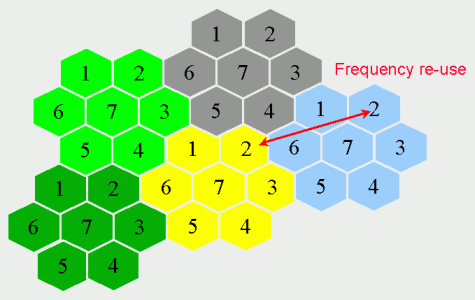Cellular network |
A cellular network is a mobile network that provides services by using a large number of base stations with limited power, each covering only a limited area. This area is called a cell. The limited power makes it possible to re-use the same frequency a few cells away from the base station without causing interference. In this way a geographic large area can be covered with only a limited set of frequencies. A cellular network is a very efficient manner of using the scarce frequency resources.
The size of a cell can vary according to the number of users that have to be served in a certain area and the amount of traffic per user. If there is much traffic in an area the cell size will be smaller than in rural areas.
This idea of frequency-reuse is given in the figure.

The total amount of frequencies is in this case divided in 7 sets of frequencies. Each set is used in another cell. The cluster of 7 cells is repeated to cover the complete geographic area.
When the user moves from one cell to another, the call must be transferred from one base station to another. This is called a handover.
The network has to keep track of the location of the mobile user to direct an incoming call to the right cell. Therefore a cellular network is equipped with a location register.
A cellular network and CDMA
In a CDMA system all cells can operate on the same frequency. The users are seperated by the use of different codes. The basic concept of a cellular CDMA network remains the same. It are only the codes instead of the frequencies that have to be distributed over the cells in such a way that the interference remains beneath a certain threshold.